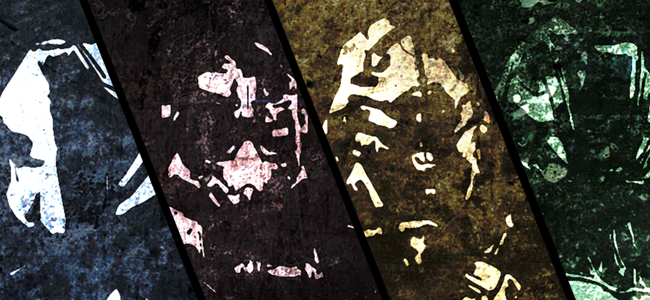
In DUST, implied combat methodology is important. Knowing which situations mitigate your suit’s and weapon’s weaknesses while playing to their strengths is critical. DUST is highly asymmetrical and as such creating, or altogether avoiding, specific combat situations is more important than in other shooters. While anyone can use any of the suits, guns, equipment, vehicles, and modules to play the game however they want; they will find using gear outside of its intended use will under-perform. Attempting to force a specific play style onto gear will have less stellar results than changing play styles or using different gear.
This article’s purpose is to discuss the differing direct combat situations each racial suit/weapon combinations excel in. Thanks to the high customization available in DUST there are, of course, no hard rules. It would also be difficult to cover all the possible fits so there will be some generalization. Support roles and indirect combat roles will only be lightly covered when they directly relate to a race’s combat doctrine. Said roles will not be covered in depth due to “holy kitten that would be a lot of words.” This is about racial game design. It is not to tell you how to play.
Each race is covered in its own section which can be accessed directly by clicking on the corresponding picture below. Each weapon icon links to Pokey’s guide on light weapons (and in fact, that weapon’s section) for more info.
Before going into racial doctrine we will quickly review the differences in Armor vs Shields. Understanding why they work and how they work is critical for understanding which situations certain suits, weapons, and play-styles are advantageous.
As a rule, armor is tougher than shields. Armor modules usually give more HP per module which gives armor suits more HP overall. Armor also has the advantage of self-repairing constantly even under fire. Over the course of a few seconds of combat this passive HP regen is often the difference between winning and losing. There are three varieties of armor plates allowing players to trade HP or speed for other bonuses such as more HP (MOAR) or faster self-repairs. Armor does not regenerate at a high rate naturally. It requires the investment of other low slots or a sacrifice of total HP to repair faster which still does not approach the speed at which shields can regenerate. Armor does have the advantage of being able to be repaired in battle via a rep tool or certain nanohives. However this means that armor is not as mobile as shields.
Armor suits generally work better with ‘stand and deliver’ play styles that emphasize tanking total damage and dropping an opponent before they themselves go down. Having a relatively lower regeneration rate isn’t as much a problem when all the enemies are dead after all. However, armor is at a disadvantage in prolonged fights where they can’t advance and corner shielded suits. In these types of fights shielded suits, which will regenerate relatively more effective HP (eHP) the longer the firefight continues, have the advantage.
Shields are generally more fragile than armor. They give less HP per module, and they cannot recharge when under fire. However, they have the advantage of being able to regenerate quickly in only a few seconds provided one can get in cover. Even as they regenerate relatively quickly on their own with no modules invested, slots can be invested to get regeneration rates even higher. They are also resistant to explosive damage making them harder to harass when behind cover.
As such shields are well suited for ‘skirmish’ type battles where mobility can be used and longer ‘pitched’ battles where one can use cover when needed while controlling range. However, as shields can’t regenerate under fire and have lower eHP totals, they are at a disadvantage out in the open without cover and in close quarters combat (CQC) when cover cannot be utilized.
As there are many suits with different slot layouts even among individual races we will be using the ‘All-Around’ Assault Specialized suits at prototype level for comparison purposes. All suits within the same race follow a similar slot pattern, therefore they more or less share the same strengths and weaknesses as their assault counterparts. For the purposes of combat method comparison, discussion will be made with all participants being mostly “racially pure.”

Gallente suits are weighted more towards low slots than high. A Gallente Assault suit has 3 high slots and 5 low slots. They have average stamina and average stamina regeneration. It is important to note that Gallente suits have the highest native armor regeneration but very low shield recharge rates and long shield recharge delays.
Gallente weapons,  are among the shortest range primaries but are the most reliable and flexible from CQC up to their optimal ranges. They have an excellent CQC sidearm which is almost as effective as a primary against both small and large groups. They also have bombardment capabilities with the Plasma Cannon.
are among the shortest range primaries but are the most reliable and flexible from CQC up to their optimal ranges. They have an excellent CQC sidearm which is almost as effective as a primary against both small and large groups. They also have bombardment capabilities with the Plasma Cannon.
This combination of weaponry and suit design implies a steady advancement and trench warfare combat methodology. Gallente suits are designed to have a healthy mix of armor regeneration and armor plates for vanguard assaults. This allows a team of Gallente suits to move up through enemy fire from cover point to cover point pausing to regenerate any damage they take. Once within medium and close range they have a distinct advantage being able to ‘stand and deliver’ (prolonged open firefight) on par with, or better than, any other race. Their weapons are extremely flexible and effective in CQC plus their suits’ ability to rep armor both passively and through equipment makes Gallente very good at digging into facilities.
Gallente weapons are steady and effective both ADS (aimed down sights) and from the hip. They also have a lot of damage in the clip making them good at engaging large numbers of opponents as they can deal a lot of damage before needing to reload. Since they rely on armor regenerate the Gallente are able to continue fighting without ducking behind cover as often as shield focused races. Their sidearm is designed to be used at close range while their primary is good for shields as they close distance. This means Gallente are able to rapidly employ all of their weapons effectively in succession as they advance.
The only disadvantage to Gallente is that they need to get relatively close in the first place. However, this is mitigated by the fact that their suit design of ‘repair damage constantly’ makes them suited for advancing on enemies as long as the Gallente can move methodically. They require less logistics suit support than other races (inherent regeneration and more ‘damage carried’ for their workhorse weapons) giving them more manpower on the front lines in terms of assaults, scouts, and sentinels.
In short: Gallente fight by moving up from point to point regenerating damage that they take while pinning opponents down with tactical weapons and mortar like explosives. Then, once within short range, they can annihilate most enemies face to face with good brawler weapons.

The Caldari are diametrically opposed to the Gallente in the EVE lore, and this is reflected in their suit and weapon design.
Caldari suits are weighted more towards high slots than low. A Caldari Assault suit has 5 high slots and 3 Low slots. They have average stamina and average stamina regeneration. It is important to note that Caldari suits have the lowest native armor regeneration, the best shield regeneration, and shortest shield regeneration delays in the game. Generally, Caldari will tank damage through shields as their suits have the most built in shield HP.
Caldari weapons  are some of the longest ranged in the game. They utilize a charge up mechanic that makes each gun more or less slower to begin firing than other race’s, as well as having high recoil making prolonged fire less effective.
are some of the longest ranged in the game. They utilize a charge up mechanic that makes each gun more or less slower to begin firing than other race’s, as well as having high recoil making prolonged fire less effective.
Considering how shields work best in prolonged firefights, and how Caldari weapons work best in prolonged long range fire fights, it implies a skirmisher focused combat style focused on keeping the enemy from moving. A squad of pure Caldari tech is very good at keeping large groups of enemies from approaching a point, provided they have line of sight. The Rail Rifle, their signature weapon, suffers from two large draw backs that puts them at a solid disadvantage in CQC, but are mitigated at long range. Rail Rifles needing to stop firing to reset recoil encourages ducking behind cover during which Caldari can regenerate shield HP.
The charge-up time and delayed fire of the Rail Rifle, while problematic in CQC, is not as bad at range because enemies have to use the Caldari pauses in firing to move position. Often times they will have left cover to advance, and be in the open too far away to reach new (or return to previous) cover easily when the Caldari resume firing. The Caldari also possess 2 of the 3 Primary Anti-vehicle focused infantry weapons making armored approach difficult.
However, if the enemy successfully gets into mid-range, suit/weapon design suggests that Caldari need to fight a retreating battle and control range until they have worn the opposing force down. Caldari are very good at hitting and moving while never letting up. Their logistics bonus allows them to use fewer hives to keep up with ammo usage, so that they can fight a moving pitched battle longer than other races, who invariably have to leave equipment behind.
In short: Caldari never let up fire wearing down opponents at long range preventing approach. They are the best at fighting retreating battles and preventing enemy movement.

Minmatar suits are unique in that they typically have the same number or very similar number of high and low slots. They have average stamina but highly accelerated stamina regeneration. It is important to note that Matari suits have the fastest movement speeds in the game as well as the most flexible slot layout but the lowest base HP.
Minmatar can choose to shield tank, armor tank, or both. Because of their high natural speed they get larger bonuses from movement modules. As such they are the best at “speed tanking;” overcoming their health handicap by taking less damage from incoming fire by simply being too fast to hit consistently. Generally speaking, 100 eHP on a Matari suit lasts a bit longer than 100 eHP on another race’s suit.
Minmatar signature rifles  are solid CQC to medium ranged weapons that put out a high volume of fire. Minmatar also have the only Anti-infantry heavy weapon, the Heavy Machine gun. Like its light weapon counterpart it puts out a veritable wall of bullets. All of their weapons are designed for destroying armor to drop opponents quickly before they get hit too hard in return. Minmatar are also the explosive specialists having both the Flaylock Pistol and Mass Driver. As such Matari weapons are good at getting entrenched enemies out of cover quickly. However, all Minmatar weapons run out of ammo quickly and must be reloaded often. In the case of the Heavy Machine Gun, a heat buildup mechanic prevents constant firing. They also have difficulty getting through shields as all of their weapons suffer a damage penalty.
are solid CQC to medium ranged weapons that put out a high volume of fire. Minmatar also have the only Anti-infantry heavy weapon, the Heavy Machine gun. Like its light weapon counterpart it puts out a veritable wall of bullets. All of their weapons are designed for destroying armor to drop opponents quickly before they get hit too hard in return. Minmatar are also the explosive specialists having both the Flaylock Pistol and Mass Driver. As such Matari weapons are good at getting entrenched enemies out of cover quickly. However, all Minmatar weapons run out of ammo quickly and must be reloaded often. In the case of the Heavy Machine Gun, a heat buildup mechanic prevents constant firing. They also have difficulty getting through shields as all of their weapons suffer a damage penalty.
The Matari weakness of Low HP and relatively limited ammo coupled with their strengths of high speed and enhanced stamina regen suggests that Minmatar are best played using hit and run style combat. Due to their high speed, Minmatar can flank quickly and easily as well as cover open ground relatively safely. Within a few seconds of stopping to fight, Minmatar recharge to full stamina and can sprint again making them able to move from engagement to engagement virtually at will. Their weapons are effective at a reasonable variety of ranges and produce high bullet volume. High bullet volume means that they are well suited for high speed combat where higher dispersion and more bullets help mitigate issues with fast moving targets or fast moving firing platforms (aka. themselves.) Their lower HP and low ammo makes them somewhat less fit for an extended engagement either face to face or in pitch battles. Minmatar can’t wait around to be hit back. However, this is also mitigated by a hit and run fighting style as it is simple for Minmatar to stop and refit/reload elsewhere on the way from engagement to engagement. –(side note)– Even Matari sentinels are as good at Hit and Run as other races’ assaults. Some of the more successful Minmatar Sentinel players run their heavy suit as an assault suit that flanks enemies, picks off 2 or 3 quickly with their high damage HMGs, and retreats to hit again from another angle.
In short: Minmatar flank and gank hitting hard and fast before escaping to reengage before reinforcements arrive or hit from a different angle.

The Amarr are diametrically opposed to the Minmatar in the EVE lore, and this is reflected in their weapon and suit design.
Amarr suits are weighted more towards low slots than high. An Amarr Assault suit has 3 high slots and 5 Low slots. They have enhanced stamina and average stamina regeneration. It is important to note that Amarr suits have the highest built-in eHP, the highest built in PG/CPU for fitting gear, and can sprint the longest. In contrast, they are also the slowest suits.
Amarr suits have many low slots, making them more suited for armor tanking. They also have a lot of stamina allowing them to stack on armor plates that have high HP values at the expense of speed. They can then use their enhanced stamina pool to run farther than other races and make up a large part of the mobility difference. They also have lower base speed than other races and as such lose less speed per high HP plate. The downside to this is that they gain less speed per Kinetic Catalyzer.
Amarr signature weapons,  are good at all ranges and stretch out as far as the long range specialist Caldari. Amarr have the Laser Rifle, which is an exceptional long range support and suppression weapon. The assault variant of the scrambler rifle is reasonably good at med range and very good at CQC to short. There is no distance at which a group of Amarr is not dangerous, however their weapons suffer from 2 drawbacks.
are good at all ranges and stretch out as far as the long range specialist Caldari. Amarr have the Laser Rifle, which is an exceptional long range support and suppression weapon. The assault variant of the scrambler rifle is reasonably good at med range and very good at CQC to short. There is no distance at which a group of Amarr is not dangerous, however their weapons suffer from 2 drawbacks.
The first is that they can overheat, damaging the user and leaving them completely defenseless. This makes them unsuitable for engaging multiple targets. Furthermore, all Amarr weapons are EM damage which means that Amarr suffer a large damage penalty when damaging armor. This disadvantage makes it hard for an Amarr to finish off an opponent that uses speed and cover to regenerate, or one who can control the timing of the fight. This is compounded by the fact that slower opponents, generally have more armor putting the Amarr at a damage disadvantage in a face to face firefight.
Considering these two things implies that Amarr combat methodology would be best summed up as this; just wrecking ball through whatever is in the way. They move slower than other races and must account for how much open ground they have to cover when advancing. This is, however, mitigated by the fact that Amarr can run considerably longer than other races without resting. Their high HP means that they don’t need cover near as much as other races. This, coupled with their long range weapons, allow Amarr to perform well on an open field as they can simply outlast whatever they are fighting when trading shots. It also serves them well in CQC. Their large stamina pool combined with the flexible weapons allow them to move to a range at which their opponents are disadvantaged without suffering a range disadvantage themselves.
In short: Amarr use flexible weapons to engage enemies at virtually any range. They use their high HP to ‘bullet sponge’ damage. Their logistics bonus allows for fast reinforcement when killed.
When gear and weapons are used along the lines of their racial combat design, weaknesses are not as weak while strengths are stronger. However, they are somewhat predictable. When you see a Caldari suit, it will probably have a longer ranged gun. If you see an Amarr suit it will probably be running an EM gun. As such, while it is important to use the above to create advantageous situations for yourself or force opponents into disadvantageous situations, you should mix it up. A Gal suit with a rail rifle staying at range is a surprise. A Min suit that is brick tanked with an assault rifle in CQC is a surprise. An Amarr suit with tons of Kin Kats, shield extenders, and a shotgun is a surprise. Do not let the above discourage you from pulling out something unexpected. Don’t be surprised if a Caldari Assault comes around the corner with a CR and a ton of Damage Mods. Keep the above in mind, but go against the grain once in a while if you are having trouble in a fight.
Finally, keep in mind that map design will not always allow a race to be played ‘properly.’ Due to hack points being largely indoors, and some map terrain being what it is, some races will have an inherent advantage, especially in objective based game modes. You might have to find yourself scaling the tactics outlined above down to smaller, more limited engagements.
Regards







Such a wonderful and helpful guide, Imp 😀 Thanks a million 😀
good
Thanks fellas. Did y’all find the Easter Eggs?